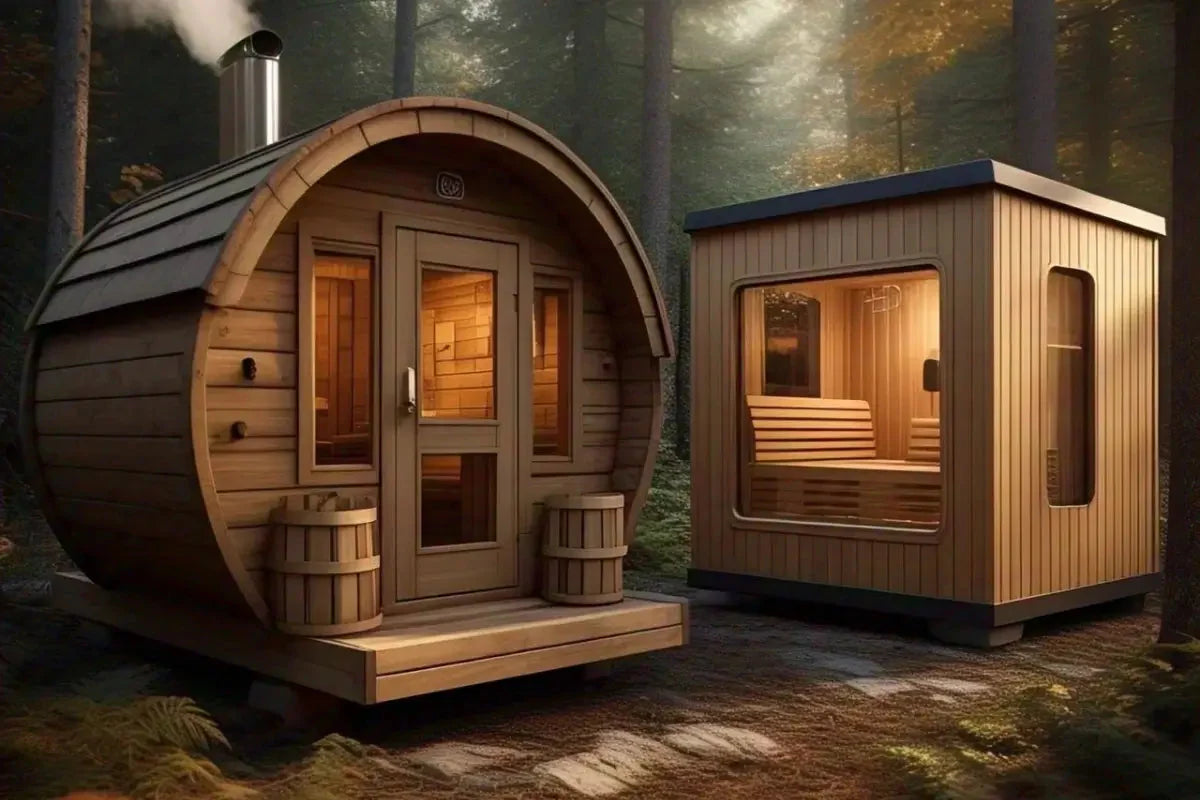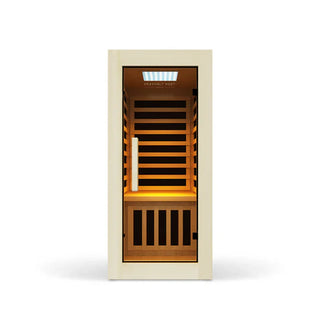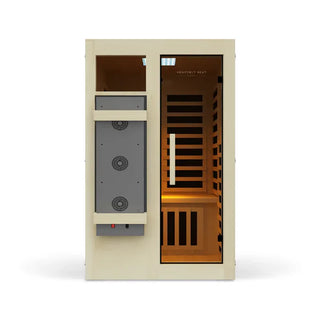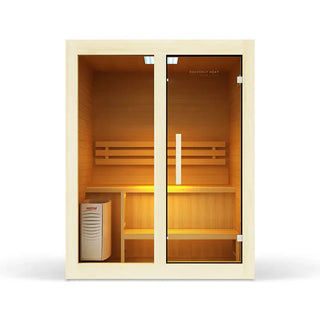Wood Burning vs Electric Sauna: Which Sauna is Better?

What is a Sauna and Its Purpose?
- A sauna helps you relax and feel better: A sauna is a small, hot room made to help you relax and take care of your health. Many people use it to calm the mind, ease tension, and feel refreshed.
- Different saunas give the same soothing effect: Some saunas use wood for heat, others use electricity or infrared light. No matter the type, all aim to give you warmth and wellness.
- Sweating in a sauna helps clean your body and boost blood flow: When you sweat in a sauna, your body pushes out toxins and your blood moves better. This helps muscles heal faster and lowers stress.
- Drinking water is important before and after the sauna: Dr. Sarah Mitchell reminds us that staying hydrated is part of a safe sauna session. Don’t forget to drink water before you enter and after you leave.
- Using a sauna often can help you sleep and feel more balanced: Frequent sauna use doesn’t just relax your body, it can help you sleep better and feel good overall. This is why it’s part of many cultures’ wellness traditions.
- A sauna helped Chef Amber heal when she couldn’t work out: After surgery, Chef Amber couldn’t exercise, so she used an infrared sauna . It helped reduce swelling and speed up her recovery in a natural way.
- Regular sauna time gave her more energy and better health: She kept using the sauna and saw big changes, not just in healing, but also in her daily energy and how good she felt overall.
- Sauna use also supports your body’s defense and burns calories: Chef Amber explains that saunas don’t just help with relaxing. They also help detox your body, boost your metabolism, and support your immune system.
How Saunas Generate Heat
- Saunas make you feel warm by heating the air and surfaces around you: Saunas create a warm, soothing environment by heating the air and the surfaces inside the room. This helps your body feel relaxed and calm as the warmth surrounds you.
- Wood-burning saunas heat the room using fire and stones: In wood-burning saunas, fire heats large stones, which then spread warmth throughout the room. This gives a natural, steady kind of heat that builds slowly and feels deep.
- Electric saunas use coils to keep the temperature steady: Electric saunas heat up using metal coils, letting you control how hot it gets. They warm up quickly and keep the room at a steady temperature , making it easy to stay comfortable.
- Good ventilation spreads the heat evenly and keeps air fresh: Ventilation plays a key role in making sure the heat is evenly spread. It also keeps the air from becoming too thick or stuffy, so the sauna feels fresh and pleasant.
- The type of heat affects how deeply your body feels the warmth: Wood-burning saunas offer slow, natural heat, while electric ones deliver quick and steady warmth. Each affects how deep the heat goes into your muscles, helping with relaxation and relief.
Wood Burning vs Electric Sauna Comparison
Heat Consistency
Electric saunas provide stable, even heat thanks to automated temperature controls, ensuring a uniform warmth throughout the space.
Wood-burning saunas, in contrast, fluctuate in warmth as the fire burns and requires occasional adjustments.
This can result in warmer and cooler areas within the sauna, making the heating experience less predictable.
Heating Time
Electric saunas heat up quickly, often reaching the desired temperature within 30 to 60 minutes.
Wood-burning saunas take longer, usually 90 minutes or more, as the fire needs time to build up and heat the stones.
The size of the sauna also affects heating time, with larger spaces taking longer to warm up in both types. If speed and convenience are priorities, electric saunas are the more efficient choice.
Energy Efficiency & Costs
Electric saunas are often more energy-efficient, particularly when powered by renewable energy sources.
Wood-burning saunas rely on firewood, which, while renewable, produces emissions that can affect air quality.
Sustainably sourced wood reduces the environmental impact, but electric saunas generally have a cleaner footprint, especially in regions with green electricity.
Maintenance & Upkeep
Electric saunas require minimal maintenance, needing only occasional cleaning of the heating elements.
Wood-burning saunas, on the other hand, require more upkeep, such as removing ash, maintaining the stove, and ensuring proper chimney function.
While electric saunas have lower running costs, wood-burning saunas appeal to those who enjoy a hands-on, traditional experience.
Installation & Setup
Electric saunas are easier to install , often requiring only a power connection, while wood-burning saunas need a stove, proper ventilation, and a chimney.
Fire safety is a crucial consideration with wood-burning saunas , as they require careful stove placement and regular monitoring.
In contrast, electric saunas reduce fire risks, making them a safer option for homes with children or pets.
Safety Factors
- Using fire in a sauna increases the chance of accidents: Wood-burning saunas use real flames, which means there’s always a risk of fire if the stove, chimney, or nearby materials aren’t handled properly.
- No flames in electric saunas means less risk: Electric saunas don’t use fire, so the chances of something catching fire are much lower compared to wood-burning saunas.
- Electric saunas are safer if kids or pets are around: If you have children or pets at home, an electric sauna is usually the safer option since there are no hot embers or open flames to worry about.
- Both types have safety features, but fire is still a bigger issue with wood: Even though both sauna types come with built-in safety systems, wood-burning saunas carry more fire risk just because they rely on real flames.
Ease of Use
Electric saunas are generally easier to use than wood-burning saunas. They often come with simple controls that allow users to set and maintain the desired temperature easily.
In contrast, wood-burning saunas require more attention, from stoking the fire to adjusting the stove for consistent heat.
While this may appeal to sauna enthusiasts, it makes the wood-burning sauna less convenient for those looking for an effortless experience.
Sauna Experience & Atmosphere
Wood-burning saunas provide a classic sauna atmosphere with the scent of burning wood , a gentle heat, and a more immersive experience.
Electric saunas, while efficient, lack the sensory elements of fire but offer convenience with precise temperature control .
The choice between the two often comes down to personal preference—some favor the traditional feel of wood-burning saunas , while others prefer the ease of electric models .
Heat Control & Distribution
- Electric saunas spread heat more evenly across the whole space: When it comes to heat distribution, electric saunas usually do a better job. Their heating elements are designed to warm up the entire room in a balanced way, so you don’t end up with hot or cold spots.
- Temperature in electric saunas is easy to control anytime: Electric saunas let you adjust the heat with the press of a button. This gives you full control and helps keep the temperature steady throughout your session.
- Wood-burning saunas can feel uneven depending on stove placement: In a wood-burning sauna, heat can sometimes gather near the stove while other areas stay cooler. It all depends on how well the heat spreads, which isn’t always perfect.
- Controlling heat in a wood sauna takes effort and doesn’t stay steady: Unlike electric models, wood-burning saunas don’t offer precise temperature control. You have to manage the fire manually, and the heat level can change during your session.
Environmental Impact
- Electric Saunas Use Less Energy When Powered by Renewables: Electric saunas usually have a smaller impact on the environment, especially if they run on clean, renewable energy like solar or wind power. This means they release fewer harmful emissions.
- Wood Saunas Release Smoke That Can Harm Air Quality: Wood-burning saunas create smoke and small particles when burning wood, which can affect the air we breathe and the environment around us.
- Using Sustainable Wood Makes Wood Saunas Greener: If the wood comes from well-managed forests, the impact of wood-burning saunas can be reduced, making them less harmful to the environment.
Sauna Preferences in Commercial Spas
Spas often feature both wood-burning and electric saunas to cater to different guest preferences. Many guests enjoy the rustic ambiance of a wood-burning sauna , while others appreciate the efficiency and convenience of an electric sauna .
High-end wellness centers prioritize energy-efficient designs , ensuring comfort while minimizing environmental impact.
Conclusion
Which sauna best fits your lifestyle? Both wood-burning and electric saunas offer relaxing heat and health benefits, but their appeal depends on your priorities.
If you enjoy the ritual of tending a fire and the natural ambiance of burning wood, a wood-burning sauna provides an authentic experience.
On the other hand, if ease of use, quick heating, and precise temperature control matter most, an electric sauna is the superior choice.
No matter your preference, investing in a sauna enhances your well-being, so why not explore your options today?











































